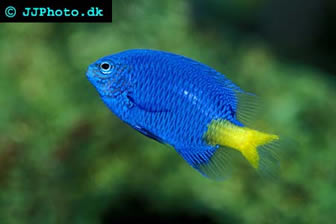Yellowtail Damsel
The fish Chrysiptera parasema is known under several different common names in English, such as Yellowtail Damsel, Yellow-tail Blue Damselfish, Blue Yellowtail Damselfish, Goldtail Demoiselle, and Yellowtail Demoiselle.
Chrysiptera parasema has not been evaluated for the IUCN Red List of Threatened Species.
Geographical range, habitat and habits
The Yellowtail Damsel is found in the Western Pacific, including the waters of Solomon Islands, northern Papua New Guinea, Philippines, and Ryukyu Islands. It may also inhabit parts of the Great Barrier Reef off the coast of Australia, but this has not been proved.
The Yellowtail Damsel is a reef associated fish that lives in sheltered lagoons and inshore coral reefs with prolific coral growth. It is know to live in small groups over patches of Acropora corals. The depth range for this species is 1-16 meters / 3-52 feet.
Size and appearance
The largest scientifically measured Yellowtail Damsel was 7.0 cm / 2.8 in.
The Yellowtail Damsel is a bright blue fish with a yellow tail that fades into clear at the edges. It is sometimes confused with its close relative the Azure Damsel (Chrysiptera hemicyanea), but the Azure Damsel has more yellow on its body than the Yellowtail Damsel. In an Azur Damselfish, the yellow colour is primarily found in the pectoral and anal fins and not in the tail.
Yellowtail Damsel care
The Yellowtail Damsel is a hardy species that can be recommended for novice marine aquarists. It is commonly used to cycle new aquarium, but you should keep in mind that adding it as the first fish to an aquarium can make it claim the entire tank as its own territory and make it difficult to add any new fish to the aquarium. This is one of the least aggressive damsel species, but that doesn’t mean that it can be considered friendly.
Another factor that will increase the territorial behaviour of a Yellowtail Damsel is to keep it as the only member of its species in the aquarium. Ideally get a group of at least 5 specimens. It is important to include a lot of hiding spots in the aquarium set-up, for the damsels as well as for any other fish. There should also be plenty of open water for swimming.
A single Yellowtail Damsel can be housed in a 20 gallon / 75 litre aquarium, while a group will need considerably more space.
The Yellowtail Damsel is considered reef safe.
Be careful when you put your hands in the aquarium because Yellowtail Damsel may bite.
The recommended water temperature is 75-80° F (24-27° C) when keeping Yellowtail Damsels. The pH-value should be in the 8.1-8.4 range and the carbonate hardness around 8 - 12° dKH. Keep the specific gravity at 1.020 - 1.025.
Feeding Yellowtail Damsel
The Yellowtail Damsel is not a finicky eater in the aquarium and will accept virtually all kinds of food, including flakes. Keep it on a varied omnivore diet to ensure optimal health. You can for instance use high-quality flakes or small pellets as a base and supplement with live, fresh or frozen meaty foods and vegetables, e.g. roman lettuce. Plankton and algae in the diet is known to be beneficial.
Give your Yellowtail Damsel many small portions of food throughout the day instead of just one or two large meals.
Breeding Yellowtail Damsel
It is difficult to sex Yellowtail Damsels based on outer appearance.
The Yellowtail Damsels is an egg-laying species. It has been bred in aquaria, but the offspring is hard to rare. The fry will often die 2-3 days after being hatched. It is important to provide them with food small enough for them to eat and keep the water quality really high. They need really tiny food, e.g. paramecium (a type of unicellular ciliate protozoa).
Damsel Species Articles
Green Chromis aka Black-axil Chromis
Blue Green Chromis
Blue Devil
Blue Velvet Damsel
Fiji Blue Devil
Striped Damsel
Blacktail Damsel
Domino Damsel
Clownfish Articles
Black Clownfish - Information about Black clown fish
Breeding Clownfish - A very brief describtion on how to breed clownfish
Cinnamon Clownfish - Information about Cinnamon Clownfish
Clarkii Clownfish - Information about Clarkii Clownfish
Maroon Clownfish - Information about Maroon Clownfish
Ocellaris Clownfish - Information about Ocellaris Clownfish
Percula Clownfish - An article about how to keep and breed Percula breeding.
Pink Skunk Clownfish - Information about Pink Skunk Clownfish
Saddleback Clownfish - Information about Saddleback Clownfish
Tomato Clownfish - An in deepth article about tomato clownfish.

